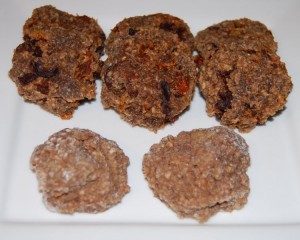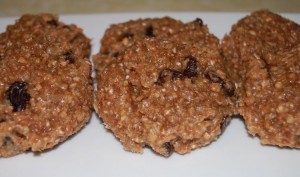A few years ago, I was listening to an interview with Kate Magic, where she mentioned that she makes a type of raw bread which her children absolutely love and would eat all the time if they could. She called it “Bread of Love” which I thought was just beautiful.

After the interview, I kept thinking about this raw Essene type of bread, but felt a little too intimidated to give it a shot. At about the same time, my husband started asking for some homemade cooked whole-wheat bread, which I was happy to make for him, and I thought “if I can make whole wheat bread from scratch, even grinding the hard red winter wheat berries, then why be intimidated by Essene bread?” I had the dehydrator, I had the wheat berries, and I had the magic of the Internet to research the topic in depth, and so I took the plunge.
So, what is Essene bread? It is a type of raw bread made of sprouted wheat berries blended with or without seasonings and left to dehydrate in the sun (or a dehydrator). We can read in the Essene Gospel of John: “And the same sun which, with the fire of life, made the wheat to grow and ripen, must cook your bread with the same fire. For the fire of the sun gives life to the wheat, to the bread, and to the body.” If that’s not a raw bread, I don’t know what is! 🙂
And, sprouting removes a lot of the gluten, so this bread is tummy-friendly if you don’t have full blow celiac but wish to avoid gluten as much as you can.
I read all I could about Essene breads, first because I like to learn from other people’s mistakes, and second because I really do not like wasting ingredients when I don’t have to. I learned a few key points:
1 – Do not sprout the wheat berries for too long. The tails should be the same size as the grain, not more. The shorter the tail, the sweeter the grain.
2 – Do not be afraid of dehydrating the bread at a higher temperature first, otherwise it will ferment and taste sour.
3 – Likewise, do not overdo it on the liquids, otherwise your bread will take longer to dehydrate and will have a greater chance of fermenting.
4 – You can use many grains, such as hard red winter wheat berries (which I used), soft wheat berries, kamut, and more. Experiment! I read that kamut is very rich in zinc and has a buttery taste. I might try it next.
5 – Essene bread does not have to be bland. It can be sweet, it can be savory, it can be anything you like.
I decided to try out a simple recipe, with a little olive oil to moisten, and some walnuts for crunch. Back when I was living in France, I used to love walnut bread, which is a nice crusty loaf studded with walnut pieces. When I came to the States, I could only find sweet rather than savory American recipes, and I just gave up trying to make the French version at home. This Essene bread is delicious, and I don’t think it tastes grassy or “raw”, two common complaints with dehydrated Essene breads.
 Mediterranean bread on top, walnut bread (frozen) at the bottom
Mediterranean bread on top, walnut bread (frozen) at the bottom
Essene-style Walnut Bread
Ingredients (makes 6 little loaves)
– 1 to 1 1/2 cups sprouted wheat berries
– 3 T – 1/4 cup extra-virgin olive oil, and water as needed
– 1/8 t sea salt
– 1/4 c. chopped walnuts, or to taste
Preheat the dehydrator to 135, while you prepare the batter.
In a food processor, blend all the ingredients except for the walnuts. When the wheat is well blended and broken down, and has the consistency and look of thick porridge, fold in the walnuts by hand.
On a non-stick dehydrator sheet, spoon the batter into 6 little mounds, no thicker than 1 1/2 inches. Each mound should be about 2 tablespoons.
Dehydrate at 135 degrees for 3 hours, then lower the temperature to 115 degrees and dehydrate for another 6 hours. If your loaves are flat, you might need less, and if they are thicker, you will need a few more hours. Flip them half way, and when they are solid enough to be handled, transfer them to a mesh tray.
Essene-Style Mediterranean Bread
– 1 to 1 1/2 sprouted wheat berries, about 1/2 cup unsprouted
– 3T – 1/4 c. extra-virgin olive oil
– 1/8 t sea salt
– 2 T chopped sun-dried tomatoes
– 2 T chopped olives
Preheat the dehydrator to 135, while you prepare the batter.
In a food processor, blend all the ingredients except for the tomatoes and olives. When the wheat is well blended and broken down, and has the consistency and look of thick porridge, fold them in by hand.
On a non-stick dehydrator sheet, spoon the batter into 6 little mounds, no thicker than 1 1/2 inches. Each mound should be about 2 tablespoons.
Dehydrate at 135 degrees for 3 hours, then lower the temperature to 115 degrees and dehydrate for another 6 hours. If your loaves are flat, you might need less, and if they are thicker, you will need a few more hours. Flip them half way, and when they are solid enough to be handled, transfer them to a mesh tray.
And what about a sweet version of Essene bread? The following recipe is inspired by Kate Magic’s Bread of Love.
 Arwen’s Elvish Bread of Love (Sweet Essene Bread)
Arwen’s Elvish Bread of Love (Sweet Essene Bread)
Ingredients:
– 1 – 1 1/2 sprouted wheat berries, about 1/2 cup unsprouted
– 2 T raw honey
– 2 T melted coconut oil
– 1 t raw honey, plus more to sprinkle on the non-stick sheet (optional)
– A little water, as needed
– 2 T raisins, soaked in water for about 20 minutes
Blend all the ingredients except for the raisins to a puree, about the consistency of thick porridge. Stir in the raisins.
Sprinkle lucuma on a dehydrator tray, and form little mounds of blended wheat onto it, for a total of about 6 loaves, no higher than 1 1/2 inch.
Dehydrate at 135 degrees for 3 hours, then lower the temperature to 115 degrees and dehydrate for another 6 hours. If your loaves are flat, you might need less, and if they are thicker, you will need a few more hours. Flip them half way, and when they are solid enough to be handled, transfer them to a mesh tray.
Join us on our Remineralize Your Body program to remineralize yourself and restore your energy, hormonal balance, and natural beauty! Learn all about juicing, blending, seaweeds, cultured drinks and fermented vegetables, phytic acid breakdown and nutrient activation, and much more, along with daily coaching with our remineralization team! – See more at Remineralize Your Body (http://www.bodyenlightenment.me/university/remineralize)

dear Joanna,
lovely website, i look forward to seeing your chocolate book in my inbox and try some goodies.
as for sprouted wheat grain breads, i cannot get any of my kids to eat them. will try your recipes:o)
coconut oil in any dehydrated stuff i tried at my place turns very strangely tasting, i do not understand why. slightly rancid, anyhow uneatable. What’s the secret, i wonder?
best from Romania,
ina
Hi Ina! Some coconut oils are just rancid. You want them to smell very fresh right away. Do you mean that they smell bad after dehydrating only?
Maybe increase the temperature first for 2 hours, then lower it? I hope it helps!